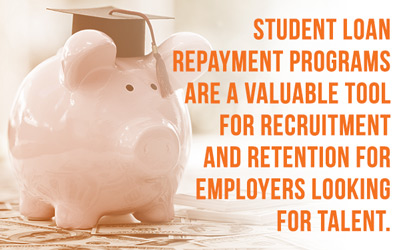Important Changes to Student Loan Repayment Programs
July 1, 2021
Student loan debt in 2021 totals $1.71 trillion across about 48 million borrowers. The average debt amount is $37,693 and is second only to mortgage debt. For employees with advanced degrees, the debt is even higher than the average. The stress of carrying student loan debt can have an impact on the financial wellbeing of an employee. An employee may be postponing contributing to a retirement account, buying a house, or marriage due to the burden hanging over their head. According to a Student Loan Hero survey, more than 64% of respondents lose sleep over money they owe and more than 67% suffer from other physical symptoms of anxiety.
Student loan repayment programs are a valuable tool for recruitment and retention for employers looking for talent. American Student Assistance (ASA) found that 86% of employees would be willing to commit five years of their career to a company that helps them pay down their student debt. ASA also found that all else being equal, a recruit would choose the employer with a student loan repayment program.
One of the barriers for employers adopting student loan repayment programs is that the amount the employer contributes towards these programs were considered taxable income to the employee receiving the benefit. According to a study by Society for Human Resource Management in 2019, only 8% of companies offered a program.
Changes under the CARES Act
The Coronavirus Aid, Relief and Economic Recovery Act (CARES) allowed up to $5,250 in student loan reimbursement. CARES, which was signed into law in March 2020, allowed the tax-free reimbursement through December 31, 2020. For employers with no program in place, this really did not spur an employer into adopting a program due to the short timeframe of tax-favored benefits.

The Consolidated Appropriations Act (CAA) extended the tax-free period from December 31, 2020 to December 31, 2025. This is a fortunate change that has gained the interest of employers looking for ways to enhance their overall benefits program, attract new talent, and retain employees.
Considerations for setting up a program
Interested employers should begin to set up programs now to take advantage of the five-year tax-favored status. There are a couple of considerations when setting up the account:
- You will need a written plan document. Most employers employ a third-party vendor to ensure compliance.
- You will need to determine eligibility requirements. Will you reimburse all employees or limit it to those with certain specialized or advanced degrees?
- Many employers are setting a limit on how much they will pay each employee in a lifetime. For example, if the lifetime limit is $10,000 and the employer reimburses at the maximum amount allowed, that may be a good tool for recruiting, but not for retention.
- What about employees who don’t have student loans or have already paid them off? There are certain plan designs that allow an employer to either contribute to a 401(k) or student loan reimbursement plan. That way, the employee can make a choice based on what works best for their financial situation.
We expect student loan reimbursement plans to increase in popularity as employers learn more about these programs. To learn more about whether a program is right for your organization, please reach out to the Parker, Smith & Feek Employee Benefits Department.
Resources and References
- Economic Effects of Student Loan Debt, EDUCATIONDATA.ORG. https://educationdata.org/student-loan-debt-economic-impact
- Total Student Loan Debt, EDUCATIONDATA.ORG. https://educationdata.org/total-student-loan-debt
- Average Student Loan Debt, EDUCATIONDATA.ORG. https://educationdata.org/average-student-loan-debt
- The Mental Toll of Student Debt: What Our Survey Shows, Student Loan Hero, Inc. https://studentloanhero.com/featured/psychological-effects-of-debt-survey-results/
- American Student Assistance Young Workers and Student Debt Survey Report Methodology, American Student Assistance. https://file.asa.org/wp-content/uploads/2018/08/14141823/asa_young_worker_and_student_debt_survey_report-1.pdf
- 2019 Employee Benefits, SHRM. https://www.shrm.org/hr-today/trends-and-forecasting/research-and-surveys/pages/benefits19.aspx
- Covid-19 Economic Relief, U.S. Department of the Treasury.
https://home.treasury.gov/policy-issues/coronavirus - About the CARES Act and the Consolidated Appropriations Act, U.S. Department of the Treasury. https://home.treasury.gov/policy-issues/coronavirus/about-the-cares-act
The views and opinions expressed within are those of the author(s) and do not necessarily reflect the official policy or position of Parker, Smith & Feek. While every effort has been taken in compiling this information to ensure that its contents are totally accurate, neither the publisher nor the author can accept liability for any inaccuracies or changed circumstances of any information herein or for the consequences of any reliance placed upon it.




